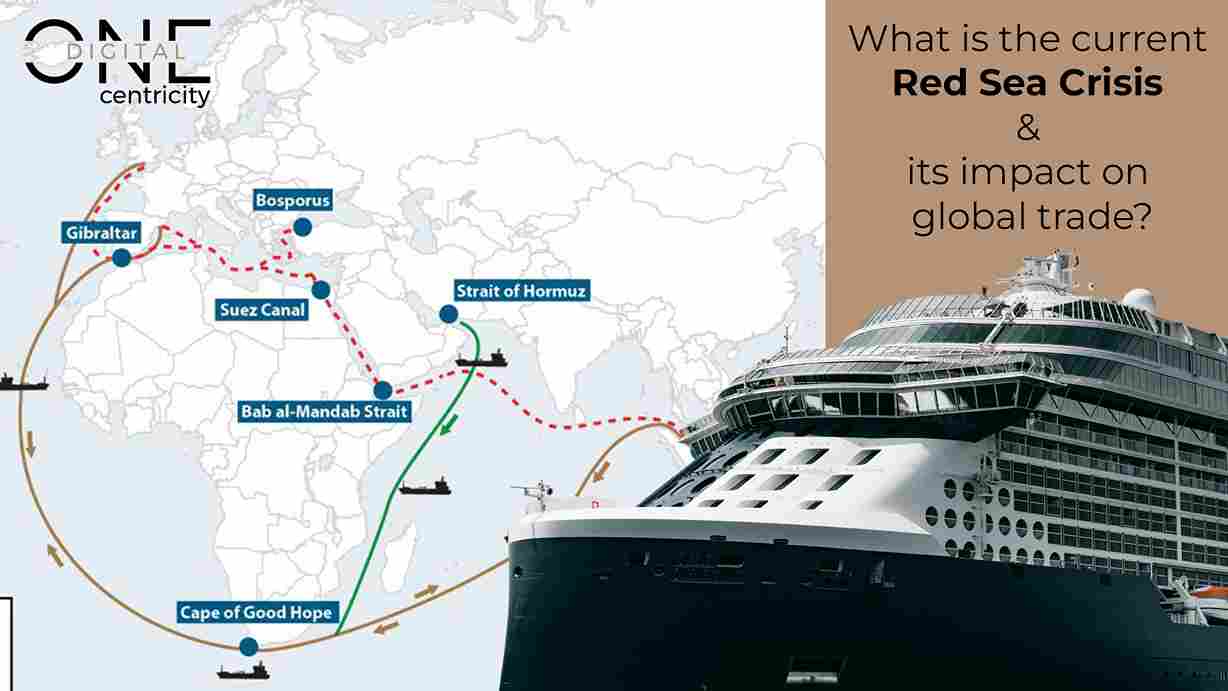What is the current Red Sea Crisis & its impact on global trade?
30th January 2024 | Author : Centricity

Initially believed to be a rebel attack, an attack now threatens to disrupt the entire global economy!
Yemen-based Houthi militias have targeted cargo ships in the Red Sea since November 2023, claiming solidarity with Gazan Palestinians.
Due to the Red Sea's two choke points, this crisis has already had a major impact on World Trade & India's trade with Europe & the US.
With rising tensions, 95% of vessels have rerouted around the Cape of Good Hope, adding 4000 to 5000 nautical miles and 15 to 20 days to their journeys. As a result, freight costs will rise, deliveries will be delayed, and global supply chains may be disrupted.
Before going further & understanding the Red Sea’s impact on India, let’s dive deep into this crisis.
Who are Houthi Rebels & Why are they attacking the ships in the Red Sea?

Why is the Red Sea so important?
The group behind the Red Sea attack, the Houthi’s, are strategically placed around the Bab-al Mandeb blocking the access for the ships. Among the 2 choke points of the Red Sea, if they block this part of the sea, it can cause catastrophe in the world trade. This is because the Red Sea is by far one of the most important trade regions of the world.

Source: SkyNews
Secondly, the Red Sea is a massive water highway of around 2,000km connecting Europe & Asia by linking the Mediterranean Sea with the Indian Ocean.
Blocking of Bab-al Mandeb compromises with the shortcut for the ships to go around the Suez Canal.
If this gets blocked, an additional 8,900kms with 2 weeks of increased shipping time will commence, hampering the time & fuel cost too!
As the data suggests, more than 1 trillion of world trade passes through this region every year. Also, 7-10% of the entire world’s oil & 8% of the entire world’s liquified natural gas are shipped through this highway.
Thus, it is an important water highway for the entire world, especially for India.
The macroeconomic effects of the Red Sea Conflict!
As a result of the Red Sea crisis, cargo shipping has been delayed and prices have increased in the short term. There is a strong likelihood that delays and cost increases will continue into the following months as shipping firms begin to prepare for a protracted conflict despite the fact that attacks on vessels are tied to the ever-changing Middle East conflict.
Bab al-Mandab passages have dropped 46% over the same period last year, according to International Monetary Fund data as of January 22, 2024. Passages through the Suez Canal are up 63% over last year, while passages through the Cape of Good Hope are up 70%. Ship diversions increase fuel and labour costs while decreasing cargo traffic reaching its destination on average.
Due to ship diversions, Egypt's Suez Canal revenues have declined. Revenues are down 40% from 2023 levels as of January 12, 2024. In addition, due to rapidly rising inflation, the government has struggled to obtain foreign currency to pay canal fees.
Diversions and subsequent price increases affect different shipping industries differently. Cargo ships, which usually transport more valuable goods, are not affected the same way as bulk carriers, which carry less valuable cargo.
A grasp of the macroeconomic effects of shipping delays can be gained from the Baltic Dry Index, which monitors the price of transporting different raw materials. Although the index reached a peak of more than $3,000 in the first to the middle part of December, as of January 22, the shipping cost has decreased to $1,503, which is around average.
However, the cost of cargo shipping has been steadily rising. This is because cargo ships carry more value than bulk carriers and are therefore more inclined to avoid the Red Sea. The average cost of shipping a 40-foot (ft) container on a cargo ship is tracked by Drewry's World Container Index, which increased from $1,521/40 ft on December 14, 2023 to $3,777/40 ft on January 18, 2024.
The largest price increases have been observed in routes that traditionally pass across the Red Sea and connect Asia to Europe. The typical shipment from Shanghai to Genoa, according to Drewry, is more over $6,000/40 feet. On the other hand, unaffected routes may experience knock-on consequences. Cargo rates from Shanghai to Los Angeles increased dramatically between December 14, 2023, and January 18, 2024, from $1,985/40 ft to $3,860/40 ft.
Even while these figures point to quick price rises, over time, other economic factors will affect shipping costs. The Financial Times reports that carrier companies have increased the number of vessels they are buying. The capacity of container transportation is predicted to grow globally by about 25% between 2022 and 2025, which will aid in price management.
Impact on Indian Business!
Due to increased container shipping costs as a result of threats to cargo vessels in the Red Sea, exporters may decide to delay shipments, potentially subtracting roughly $30 billion from India's overall export earnings in the current fiscal year. The shipping routes to Europe & U.S. is taking longer, thus increasing the overall shipping cost of Indian goods to these markets up to 20-30%.

Additionally, Kanpur exports leather, plastic & spices worth Rs. 300 crore every month to Europe. Last year only, India exported Rs. 5500 crore worth of goods to Europe. Due to this situation, consignments worth Rs. 100 crores have been held back.
Not only this, in FY23, India has exported Rs. 38,524 crores of Basmati rice. According to the Former President of All India’s Rice Exports Association, the freight cost for India’s Basmati rice to countries around the Red Sea has jumped from $600 per tonne container to $2,000 given the risk.
According to Freightos.com, a cargo booking and payment portal, the spot pricing for shipping products in a 40-foot container from Asia to northern Europe currently exceeds $4,000, a 173% increase from shortly before the diversions started in mid-December. A 40-foot container now costs $3,900 on the East Coast of North America, a 55% increase from Asia.
Disclaimer: The information presented in our newsletter and blogs is solely for informational purposes.

How reliable are your financial advisors?
19th September 2024

Is NPS a tax-efficient financial instrument?
19th December 2023

Psychology of investing: What is behavioural finance?
13th February 2024

What was the Subprime Crisis of 2008?
21st February 2024

How to build a strong money mindset for 2024?
27th February 2024

